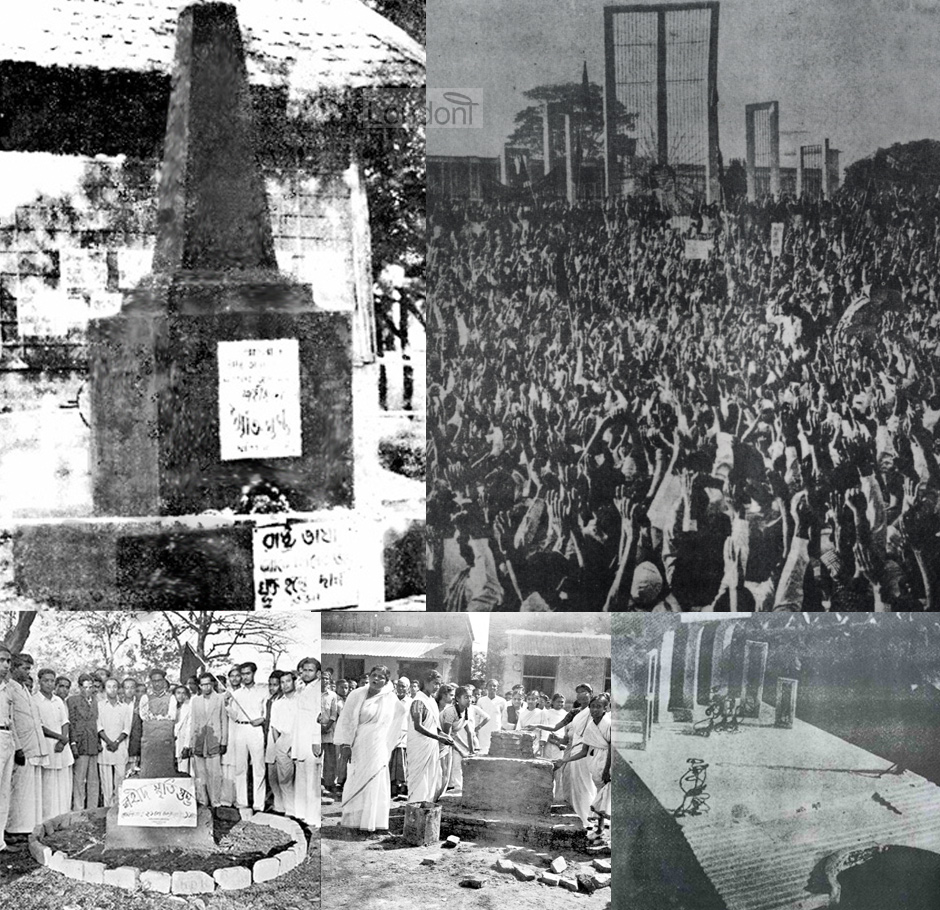
Shaheed Minar
Last updated: 5 October 2017 From the section 1952 Bhasha Andolon
First Shaheed Minar built two days after Ekushey (1952)
Two days after Ekushey February, on 23 February 1952, the students of Dhaka Medical College erected a column (minar) – known as Shaheed Minar (Martyr's Memorial) – as tribute to the martyrs who given up their life for the Bengali language. The main incident had been occurring inside of Dhaka medical college hospital (DMCH), so a decision was taken to build a memorial adjacent to DMCH on the spot where the shootings had taken place: the south-eastern corner of the present Shaheed Minar premises, in the Dhaka University area. It is adjacent to the Mathematics department of Dhaka University and is only 0.5 km away from Shahbag and 0.25 km far from Chankharpul.
This minar was sponsored by Pearu Sardar, one of the old dhaka panchayet sardars when some of the students asked his help at the midnight of 22 February 1952 to contribute the raw materials needed to build the monument.
Planning on the small symbolic structure measuring 10.5 ft high and 6 ft wide started that night and even though a curfew was in place, construction began the next day in the afternoon. The students worked through the night and finished it by midnight.
Immediately after construction, a plate with the words 'Shahid Smrtistambha' (monument in the memory of the martyrs) hand written on it was affixed to the monument.
The memorial was formally inaugurated by Abul Kalam Shamsuddin, the then editor of the daily Azad, on the morning of 26 February 1952. Others attribute this inauguration to the father of slain activist Sofiur Rahman.
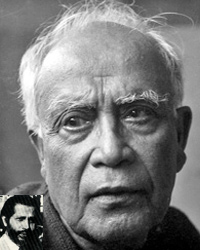 Abul Kalam Shamsuddin ()
Abul Kalam Shamsuddin ()  Pearu Sardar ()
Pearu Sardar ()
Nevertheless, the police retaliated by cordoning the Medical College hostel that afternoon and demolished the monument – three days after its construction.
Although the monument was demolished, the Pakistani ruling coterie could not efface the memory of the martyrs. Innumerable small memorials on the same model were built all over the country, specially in the educational institutions.
Jukta Front promise to build an official monument after landslide victory in general election
In 1954 major opposition political parties of East Pakistan formed the Jukta (United) Front and stood against the ruling Muslim League Party in the first general election of East Pakistan, held in March 1954.
As part of their election pledge the United Front formulated a 21-point program and promised:
- Bengali shall be made one of the state language of Pakistan.
- Arrangement will be made to impart education through the mother tongue only.
- The United Front will change the residence of the Chief Minister (as the then chief minister of the province, Nurul Amin, was responsible for the Ekushey February killings) and that the residence would be converted into a center of research for Bengali language and literature. [The Bengali Academy is housed in that building, Burdwan House, at the moment]
- In memory of those killed on Ekushey February a befitting martyrs’ column will be set up at the spot of the killing and compensation will be given to their families.
- Ekushey February will be declared as the "Shaheed Dibosh" (Martyrs' Day) and made a government holiday.
That the magic figure of 21 became a symbol of struggle, national unity, and emancipation, became clear when the major opposition political parties of East Pakistan formed a united front on the basis of a 21 point program.
In the subsequent general election, the Jukta Front won an overwhelming victory and formed a government on 3 April 1954 which was led by A. K. Fazlul Huq and the Awami League. In the Session of 9 May 1954 the government announced that, according to their commitment in the 21-point programme, the Shaheed Minar would be built. 21 February was declared as Shaheed Dibosh (Martyred Day) and also as a public holiday.
However, the Jukta Front Government could not execute its decision as it was ousted from power three weeks later, on 30 May 1954, by the West Pakistani government.
They would have to wait nearly two years when on 21 February 1956 the foundation stone of the Shaheed Minar was laid for the second time by Abu Hossain Sarkar, the then Chief Minister of East Pakistan, along with Maulana Abdul Hamid Khan Bhashani and Hasina Begum, mother of Abul Barkat, the language martyr. On this day 'Ekushey February' was once again formally declared as Shaheed Dibosh and a public holiday and for the first time the anniversary of the language martyrs was observed in a peaceful and honourable manner.
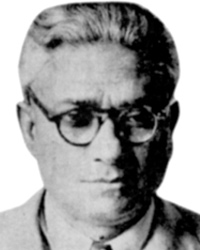 Abul Hossain Sarkar ()
Abul Hossain Sarkar ()  Hasina Begum ()
Hasina Begum ()
Hamidur Rahman and Novara Ahmed build a powerful, symbolic second one (1963 – 1971)
When the Awami League government came to power in 1956, it became possible to construct the new monument to commemorate the protesters who lost their lives. Chief Minister of East Pakistan Ataur Rahman Khan requested Chief Engineer Jabbar and Zainul Abedin to ask famous architect Hamidur Rahman to prepare a plan for a larger Shaheed Minar in the yard of the Dhaka Medical College Hostel.
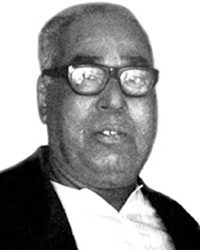 Ataur Rahman Khan ()
Ataur Rahman Khan () 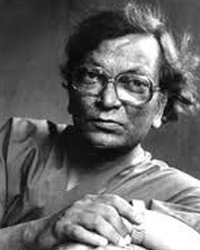 Hamidur Rahman ()
Hamidur Rahman ()
He had designed a massive Shaheed Minar complex on a large area of land. The enormous design included a half-circular column to symbolize the mother with her fallen sons standing on the dais in the main part of the monument. Many yellow and deep blue pieces of glass were to be imbedded in the column as symbols of eyes from which the rays of the sun would be reflected. The marble floor was designed to reflect the moving shadows of the columns. The basement of the Minar also included a 1,500 sq ft (140 m2) fresco depicting the history of the language movement.
Besides these, there was to be a railing adorned with the Bangla alphabet in front of the monument complex and also two footprints, one red (indicating the blood-stained footstep of the shaheeds) and one black (indicating the aggressor), symbolising the two opposing forces. The design also included a museum, a library and a series of mural paintings. At one end there was supposed to be an eye-shaped fountain with a high undulating platform. Rahman specifically designed the materials of the monument to withstand the area's tropical climate.
The central, largest column bends at an angle toward the other columns and is widely regarded as representing a mother bestowing love, affection, and protection on her children.
The region of Bengal is the mother, and the children are the martyrs and ultimately all Bengalis – that is, anyone born in the region and speaking the language. The monument serves, therefore, to reinforce a natural bond between land and people, a bond central in creating a secular nationalist sentiment. Many Bangladeshis see the Shaheed minar’s numerous destructions as a powerful reminder of the oppression that the region’s people have overcome.
Based on this design, the construction work was started in November 1957 under the supervision of Hamidur Rahman and sculptor Novera Ahmed along with the staff of the then Construction and Building Directorate. This time the basement, platform and some of the columns were completed. The rails, footprints, some of the murals as well as three sculptures by Novera Ahmed were also finished. However, marital (military) law was introduced by Ayub Khan in 1958 and the construction was forced to a halt. Despite this, people continued to visit the Shaheed Minar to place floral wreaths and hold meetings.
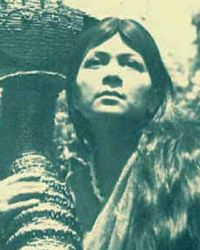 Novera Ahmed ()
Novera Ahmed ()
A committee, formed in 1962 under the order of Azam Khan, the then Governor of East Pakistan, and headed by the Vice-Chancellor of Dhaka University, suggested extensive changes in the original design of the Shaheed Minar. As such the design was changed, leaving much of Rahman’s design unfinished, and the construction resumed under the supervision of Greek architect Doxiadis, who was then working at the Construction and Building Directorate.
It was completed and inaugurated on 21 February 1963 by Abdul Barakat’s mother, Hasina Begum.
Reconstructed after Swadhinata Juddho
Though reduced and curtailed, the Shaheed Minar became the symbol of the spirit of the Language Movement in the mind of the people. The monument stood in its solemn glory until the Bangladesh Liberation War in 1971, when it was demolished completely during Operation Searchlight, a genocide carried out by the Pakistani Army resulting in an estimated 50,000 civilian deaths. The Pakistani Army crushed the Minar and placed over the rubble a signboard with the word ‘Mosque’ written on it. The mosque was not built, and in 1972, after Bangladesh had attained its independence, new initiatives were taken to construct the Shaheed Minar once again.
A committee was formed under the guidance of the then president Abu Sayeed Chowdhury and renovation work began. The original sketch was ignored and the Construction and Building Directorate followed the abridged design of 1963.
This time also the construction was hastily completed.
The murals destroyed by the Pakistani army were not restored and the basement was sealed off. Hamidur Rahman’s original design was not approved by the directorate in the renovation work.
In 1976 a new design was approved, but it was not implemented.
The Shaheed Minar, with all its architectural and sculptural imperfections, still stands as a symbol of the linguistic and nationalistic struggle of Bangladeshis.
In the mid-eighties, the monument underwent further renovation under the supervision of the then Department of Architecture chief architect SHM Abul Bashar, which extended the area of the Shaheed Minar premises, giving it a square shape from a triangular one. However, there were still supporters who demanded proper implementation of the original design by Hamidur Rahman which he created with the help of sculptor Novera Ahmed and Danish architect Gean Deleuran. They highlighted the maltreatment and degradation, such as, how due to the the extension, two entrances to the basement murals were permanently closed and after remaining in an abandoned state for 15 years, the murals had lost much of their gloss. Subsequently in 1983, the Shaheed Minar was expanded to its present dimensions.
In the 1983 renovation, the original poor materials were lined with marble stone. A museum and library were also featured in the original plan. On 25 August 2010, the High Court issued nine directives for the maintenance and renovation of the Shaheed Minar and asked the Public Works Department to establish a museum and a library on its premises.
Despite some flaws of proportionality, the Shaheed Minar still stands high. It is one of the city's most important monuments. The Shaheed Minar of Dhaka has a very close association with the city's cultural history. It also happens to be one of the primary Dhaka Tourist Attractions and is visited by thousands of tourists throughout the year.It is one of the most well-maintained monuments in Bangladesh. Special care is taken each year on the occasion of 21 February (Ekushey February). The premises are washed and cleaned thoroughly. Artists of the Faculty of Fine Arts of Dhaka University then colorfully paint the Central Shaheed Minar premises with intricate designs. Thus the Shaheed Minar premises are colorful throughout the year.
The Central Shaheed Minar of Dhaka goes up to a height of 14 meters and is a brilliant piece of architecture which has been made with marble stones. The staircases and barrier are highlighted white to create a divine look. The fence on both sides is painted with lines from poems of legendary poets in iron letters. As the visitors enter the monument they will find two statues of the patriots who sacrificed their lives in that tragic police firing of 1952.
Hurried repair of the Shaheed Minar resulted the Minar to be constructed incorrectly. The height of the column was shorter and the head bent more than originally planned, and the proportions of different parts of the monument were not properly maintained.
The language movement was one of the formidable movements which has come up in the country of Bangladesh, thus The Central Shaheed Minar epitomizes in other words represent the spirit of Bangladeshi nationalism and also highlights the importance of the Bengali language in the social and cultural progress of the country. As a result The Shaheed Minar has a very significant place in the social and cultural mechanism of Bangladesh.
At present, all national, mourning, cultural and other activities occurred each year regarding 21 February is centered around the Shaheed Minar.
